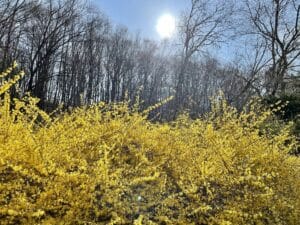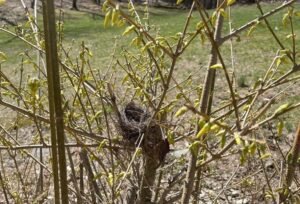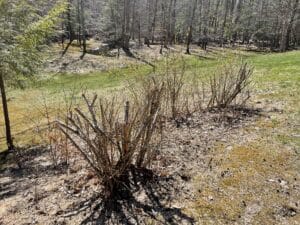Hello, fellow lovers of all things green. Denise from Mt. Tabor, PA, asked why her forsythia aren’t blooming. You’re not the only one, Denise; mine hasn’t either for over two years. Non-blooming forsythia most often results from improper pruning, though deer browse, not enough sunlight, improper fertilizing, or winter kill may also cause it.
Why do folks prune forsythia in unnatural shapes?
Forsythia spreads readily, so I never recommend planting them close to the house. They are beautiful, left in their natural weeping shape at the edge of a property. They are one of the first shrubs to bloom, the sunny yellow lights up the bland landscape, welcoming Spring. However, they can indeed turn into unwieldy shrubs, inspiring folks to prune them into unnatural shapes or hedges.
Despite its high rating of deer resistance, darn deer will nibble the newer growth if they’re starving during snowy winters. Forsythia blooms on year-old wood, meaning this year’s new growth will bring next year’s flowers. So, if deer nibbled, you’ll miss the sunny flowers. The same is true if frigid winters cause bud die-back; not likely the case this winter as snow is an excellent insulator.
Non-blooming forsythia is often from improper pruning.
Forsythia needs about six hours of sunlight to bloom. And too much nitrogen can hinder bud production. So, if you are spreading lawn fertilizers high in nitrogen (please don’t), adding phosphorus, such as bone meal, should help counteract the nitrogen overload. Most often, however, the lack of blooms is caused by improper pruning. Maybe you have a stealth pruner at home, too, Denise?
Unknown to me, my dear Curt pruned the branches within reach several times during the summer a few years ago. The outcome – a mohawk haircut of sorts – clipped on the sides and loosely wild on top. Hey, it’s a style, and isn’t fashion a matter of taste? :^# It’s true the shrubs were getting unwieldy.
The proper way to prune forsythia each year
The proper way to prune forsythia to maintain its graceful shape is to cut out the older branches at the plant’s base. Like most flowering woody plants, it’s best to prune soon after the bloom cycle. Never use hedge clippers to sheer the ends of forsythia, as the plant will remain dense with old wood in its core, suffocating new branching and inhibiting bloom. There, there, Curt.
If your forsythia is way out of control and driving you batty, you can rejuvenate them in early Spring by cutting them almost to the ground. Of course, you’ll miss flowering the first year, and it’ll take a few years to return to the desired height. I gave Curt the go-ahead to rejuvenate prune after I noticed the bad haircut.
How to rejuvenate prune forsythia.
Another way to rejuvenate prune and not lose a year of sunny yellow and maintain a hedge height is to remove a third of the oldest branches the first year, cutting them to the ground. Then, cut another third the next year and another third the year following, being sure to cut back the old wood only.
In all fairness, when it came time to refresh the plants, I coached Curt to cut back the stems at random heights from four to eight inches. A few years ago, I used the same technique to rejuvenate prune Leatherleaf Viburnum riddled with aphids, which worked famously. I later learned that cutting forsythia to the ground is the correct way. And by the time we got to cutting them back, it was early June. What remains of our forsythia are new stems on old wood. Not so pretty.
Rather than the familiar Forsythia x intermedia, which grows 8 to 10 feet tall and 10 to 12 feet wide, you can plant smaller cultivars such as ‘Golden Peep,’ ‘Goldilocks,’ and ‘Gold Tide’ that stay 4 feet or less. There are white and pink varieties, Abeliophyllum distichum and A. ‘Roseum,’ that also stay 4 to 5 feet. That way, there’ll be no risk of bad haircuts.
Garden Dilemmas? AskMaryStone@gmail.com (and your favorite Podcast App.)
You’ll enjoy the story of rejuvenating our Leatherleaf Viburnum featuring special baby robins in Reasons to Prune.
Links to smaller forsythia ‘Golden Peep,’ ‘Goldilocks,’ and ‘Gold Tide.’






Its been 3 years since I’ve had yellow on my forsythia after my husband pruned it at the wrong time. Will it ever bloom again. It gets green leaves but no yellow
Hi Judy, Forsythia blooms on old wood. So, it should have recovered from your husband’s untimely pruning after one growing season without blooms. Perhaps yours is being nibbled by deer? Or not getting enough sun? Or, like my Curt, your hubby is secretly pruning it without you knowing? Smile. Thank you for reading my post, Mary Stone
Do you have a properly pruned forsythia to share with us?
Hi Ellen, The proper way to prune forsythia to maintain its graceful shape is to cut out the older branches at the plant’s base. The best time is in late winter or early spring before the bloom so you can easily see the older branches. I’ll try to remember to take a photo next time I perform the task. Thank you for writing in, Mary Stone
Mine has never bloomed so I planted two more, one on each side. Now, nothing blooms in five years.
Very frustrating, going to dig them up and move them to a sunny spot.
Hi Jerry, Forsythia definitely prefer full sun. Hopefully the move will encourage them to flower. Thanks for reading my post, Mary
3 years ago, my mom gave me a shoot of her forsythia bush. I planted it in my garden I was creating in our new townhouse. Unfortunately, for 2 years in a row the landscapers at our complex weed whacked the heck out of the poor thing. Lucky, it kept growing, but as you can imagine, it’s quite small. We created a garden brick carrier so the landscapers leave it alone. Now that it will hopefully be left alone, do you have any advice for me to help it thrive and eventually flower?
Hi Devon, Poor thing… Protecting it from being pruned is the best bet. And being sure it is getting at least six hours of full sun per day. Good luck! And thanks for reading my post, Mary Stone